The Bloomsbury Group escaped to rural East Sussex in search of creative freedom and inspiration. Novelist Virginia Woolf retreated to Monk’s House in Rodmell, while artists Duncan Grant and Vanessa Bell lived amongst the South Downs at Charleston Farmhouse, famously painting the interior of nearby Berwick Church.
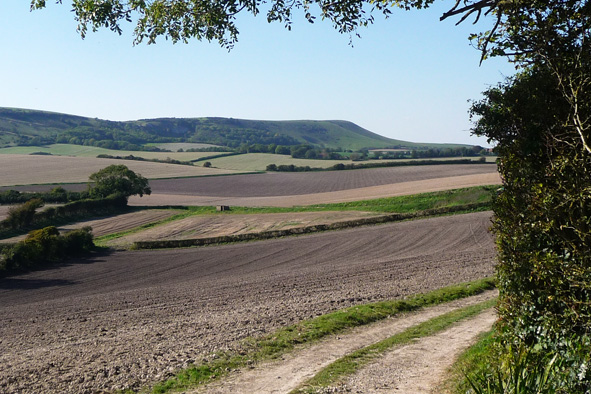
South Downs scenery (Photo: Rebecca Steel)
The Bloomsbury Group was an informal circle of friends named after the London setting where they met during the first half of the 20th century. At the group’s centre were brothers Adrian and Thoby Stephen, their sisters Vanessa and Virginia, plus acquaintances from Cambridge University. Intellectual discussions and debate took place between group members, which included writer E. M. Forster, economist John Maynard Keynes, biographer Lytton Strachey, and art critics Clive Bell and Roger Fry. They were ahead of their time in terms of attitudes to aesthetics, fashion, gender, politics, sex and war. I wanted to fully appreciate their creative influences by visiting three East Sussex locations closely associated with the group. I also wanted to learn more about their unconventional lives, which involved two World Wars and a shift away from Victorian principles.
Berwick Church
Berwick Church was my first port-of-call in the morning because the other sites didn’t open until the afternoon. I parked my car opposite The Cricketers’ Arms in the tiny village of Berwick. The church was tucked away in a secluded spot overlooking the dramatic hills of the South Downs National Park. Saint Michael and All Angels looked just like any other Downland church from the outside, but stepping inside revealed the most surprising of sights. Colourful murals covered the walls of the nave, chancel arch, screen and pulpit. Biblical scenes confronted me from all angles. They were lit-up when someone pressed a light switch at the back of the church, allowing me to take a closer look at these giant works of art.
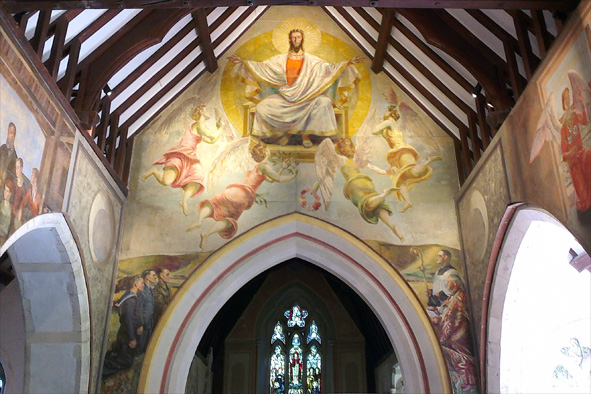
The nave at Berwick Church (Photo: Rebecca Steel)
Duncan Grant, Vanessa Bell and Quentin Bell painted the murals while they were living three miles to the west of Berwick in Charleston Farmhouse. Bishop Bell of Chichester commissioned the murals as an experiment in uniting the Church with the Arts. They were painted during the Second World War at a time when artists were struggling for survival, therefore it was hoped that this scheme would encourage similar ones around the country. Pre-Reformation churches would have been covered with murals; therefore the artists were simply continuing a very old tradition. Duncan had also been inspired by his travels to religious sites in Italy, resulting in the use of symbolism and techniques from earlier forms of Christian art.
Quentin’s depictions of the sacraments looked distinctly Victorian, but the remainder of the paintings also felt quite traditional. The artists’ Post-Impressionist tendencies of visible brush strokes and fluid shapes must have been tamed for these murals. The only exception was the pulpit with its lively flower and fruit designs painted in the 1960s over the top of Vanessa’s depictions of saints, which had been vandalised. The artists seem to have kept their colour palettes fairly conventional, although I noticed Duncan’s daring use of bright orange and blue in The Victory of Calvary/ The Crucifixion.
The sensitivity towards the congregation was very apparent. By incorporating scenes from the South Downs the Bloomsbury artists had brought Christianity closer to the local community. Vanessa’s nativity scene depicted a hill that looked just like Mount Caburn near Lewes, while Quentin’s The Supper at Emmaus showed a quarry in the background, which was a regular feature of the surrounding landscape. Moreover, the congregation would have recognised some of the people in the paintings because the artists asked local farm workers and children, alongside their own friends and family, to be models for their preliminary sketches.
Charleston
My next destination was a farmhouse just a few miles away, which Duncan Grant and Vanessa Bell had made their home a century ago. Hidden down a quiet country lane, it was a beautifully remote location that would have appealed to their artistic sensibilities. Virginia Woolf spotted the farmhouse on her regular walks along the Downs and thought it would be ideal for her sister, despite its rundown state. It was also a good location for Duncan to find work labouring on farms during the First World War to avoid conscription.
Duncan and Vanessa moved to Charleston in October 1916, along with Duncan’s bisexual partner, David Garnett, and Vanessa’s two sons, Julian and Quentin. The father of the two boys was Clive Bell, whom Vanessa had married but never divorced. The family stayed on good terms with each other; Clive often visited Charleston and even lived there temporarily. Nevertheless, their lives were to remain complicated. Vanessa desperately wanted a baby with Duncan, whom she adored. He obliged, which led to the birth of baby Angelica on Christmas Day 1918 at Charleston. To avoid controversy, Clive agreed to pretend the baby was his own. Angelica herself wasn’t told the truth about her real father until she was 17 years old. She would even go on to marry David, her father’s former lover. Such was the controversy that simply added to the notoriety of the Bloomsbury Group in more recent decades.
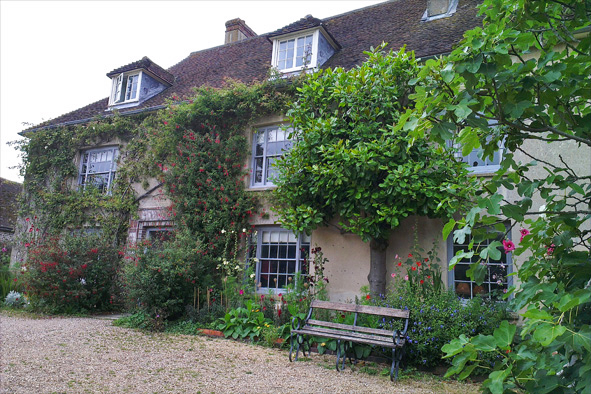
Charleston Farmhouse (Photo: Rebecca Steel)
After lunch in the café I went on a pre-booked tour of the house. This guided tour lasted an hour, giving a detailed insight into many aspects of the occupants’ lives. The house interior had been restored to its 1950s appearance. In its completeness it was the only surviving decorative scheme by the Bloomsbury artists. Duncan and Vanessa didn’t just decorate the walls; they painted the doors, fireplaces, windows and furniture with their lively, individualistic designs. It was as far removed from Vanessa’s upper-middle-class upbringing as she could muster.
In the dining room the evolution of Duncan and Vanessa’s creativity was most obvious. The works on display here demonstrated their progression from a late Victorian method of painting to a more modern, Post-Impressionist style. They were inspired by Roger Fry, who shocked the general public by bringing the first Post-Impressionist exhibition to London in 1910. He had also set up the Omega Workshops to create modern furniture, textiles and household accessories utilising designs by the Bloomsbury artists. These avant-garde designs could be witnessed throughout Charleston.
I discovered that it wasn’t just the Bloomsbury artists who were making their mark in the history books. The many bedrooms of Charleston were often used to accommodate friends who were prominent in each of their respective fields. There were also connections with the Surrealists and other artists who stayed at nearby Farley Farm House. It was these friendships, plus foreign travel and associations with art critics, which led to the walls of Charleston becoming adorned with works by the likes of Picasso, Renoir and Sickert.
The final room of the tour was the real showstopper. Walking through Vanessa’s downstairs bedroom I wasn’t expecting a door to open into a lofty art studio. Canvases, drawings, pottery and sculpture were some of the treasures on display here. It was in this studio, next to the fire, that Duncan chose to spend his time after Vanessa had died.
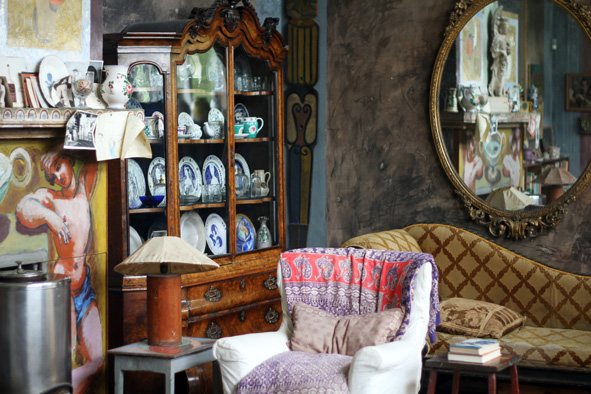
The studio at Charleston Farmhouse (Photo: The Charleston Trust, Ëpha J. Roe)
I strolled into the Mediterranean-inspired walled garden, which was at the height of its summer beauty. Abundant flowers crowded the borders and almost blocked the pathways. The colour and chaos seemed to mirror the lives of the Bloomsbury Group. Their influence could also be seen in the eccentric positioning of ponds, mosaics and classical-looking statues. On my way out I admired Quentin’s striking sculpture of a lady lying sideways, her legs suspended off the ground as though defying gravity. Then it was back down the bumpy country lane and on to the final stretch of my journey.
Monk’s House
Half way along the winding road between Lewes and Newhaven I found the quaint village of Rodmell where Monk’s House was located. This former home of Leonard and Virginia Woolf was more humble than I imagined. The weather-boarded cottage exuded a rural, laid-back charm. It was originally several cottages that had been joined into one and extended over the years with a glass conservatory and a garden studio that could be booked as holiday accommodation.
The National Trust had arranged the ground floor of Monk’s House to reflect its heyday. The sitting room was painted in Virginia’s favourite shade of green and contained furniture displaying typical designs from the Omega Workshops. Literature referring to Leonard and Virginia’s intellectual and political activity had been placed carefully around the room. In a prominent position was the desk where the couple maintained the business of running the Hogarth Press. It was this publishing company that kept them tied to premises in London, using Monk’s House as a country retreat to which they could escape for weekends and holidays.
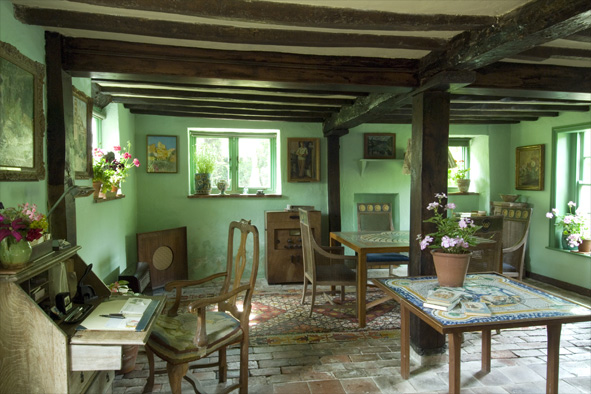
The sitting room at Monk’s House (Photo: National Trust, Caroline Arber)
Throughout the house were paintings, furniture and ceramics by Bloomsbury Group members and friends of the family. One of the more interesting rooms was Virginia’s ground-floor bedroom at the far end of the cottage. Shelves of her books were on display, translated into other languages, plus a set of Shakespeare plays that she had carefully decorated with matching covers.
The garden at Monk’s House was another great passion for the Woolfs, especially green-fingered Leonard. Stepping outdoors revealed dazzling flowerbeds and alcoves that gave way to lawns, ponds, fruit trees and vegetable plots. The only building seen from the garden was a picturesque 12th century church set against the backdrop of the South Downs. Virginia’s writing lodge could be found at the back of the garden; a peaceful refuge where she penned her novels. From here French doors opened onto the lawns where the couple played bowls and hosted many a bohemian gathering.
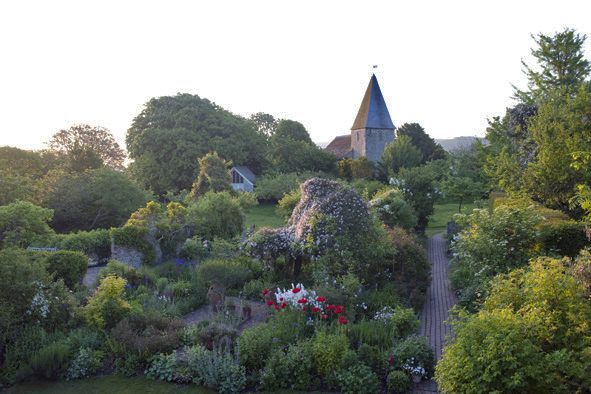
The garden at Monk’s House (Photo: National Trust, Caroline Arber)
In addition to the beauty and intrigue at Monk’s House was the lingering sense of melancholy. Unfortunately Virginia Woolf was living here when she committed suicide by drowning herself in the nearby River Ouse. She had just completed the manuscript for Between the Acts (published posthumously), which had taken its toll on her health. Virginia didn’t want to burden Leonard any longer with her bouts of mental illness. Her death in 1941 also happened when she was trying to block out the horrors of the Second World War. She had even made a suicide pact with Leonard, who was Jewish, should their worst fears have been realised. Moreover, the couple had only recently moved to Sussex on a permanent basis because their London address had been obliterated by bombs.
Virginia’s death would have been especially hard for her sister at a time when Vanessa was still recovering from her son’s early demise. Julian Bell (1908-1937) had tragically lost his life as an ambulance driver in the Spanish Civil War; a conflict that his pacifist family had urged him not to participate in. It was also sad to think that Leonard lived the rest of his life in Monk’s House without Virginia, but he must have taken comfort from their shared surroundings. He can also be credited with offering the biggest insight into Virginia’s writing by allowing her diaries, letters and notebooks to be published in later years. This helped sustain interest in her life and work, as well as that of the wider Bloomsbury Group. It is this continued interest that has helped to fund the conservation efforts at each of the sites mentioned, allowing these unique places to remain intact for future generations to enjoy.
Further Information
Berwick Church is open all year (with some exceptions). Charleston and Monk’s House are open spring to autumn on Wednesday to Sunday afternoons only.
Walkers and cyclists may wish to use the scenic South Downs Way to visit any of the three East Sussex locations.